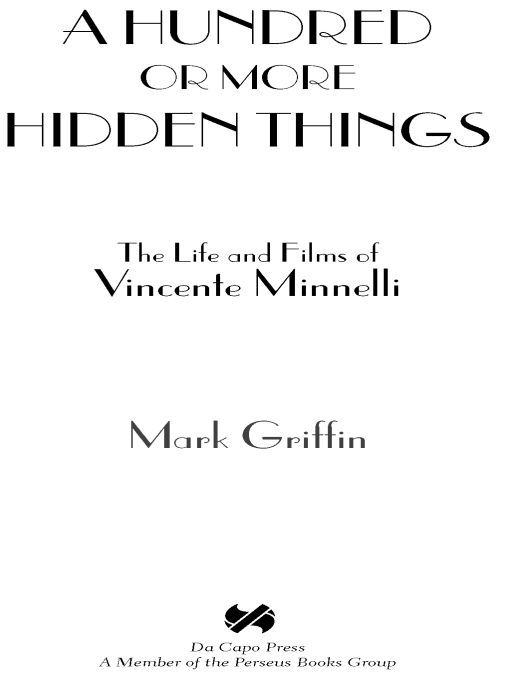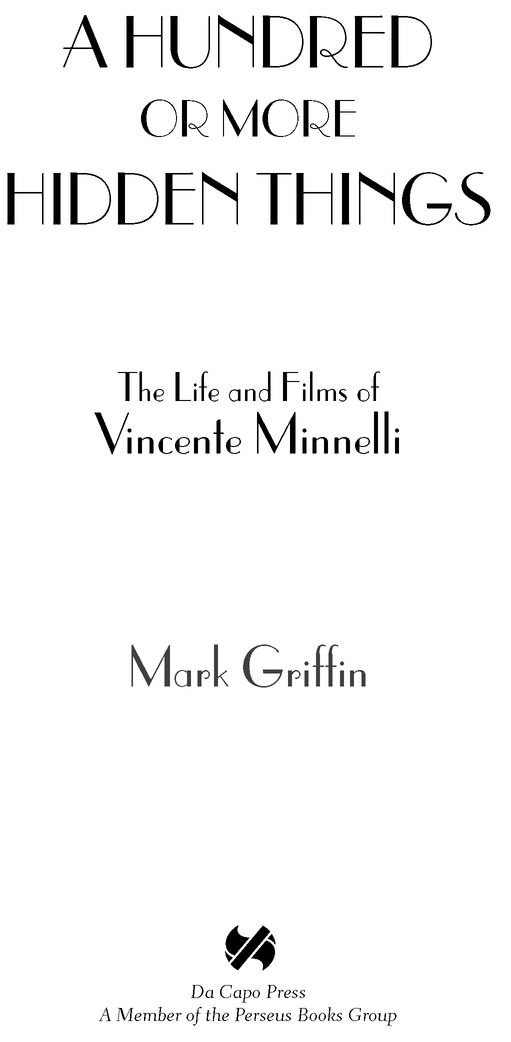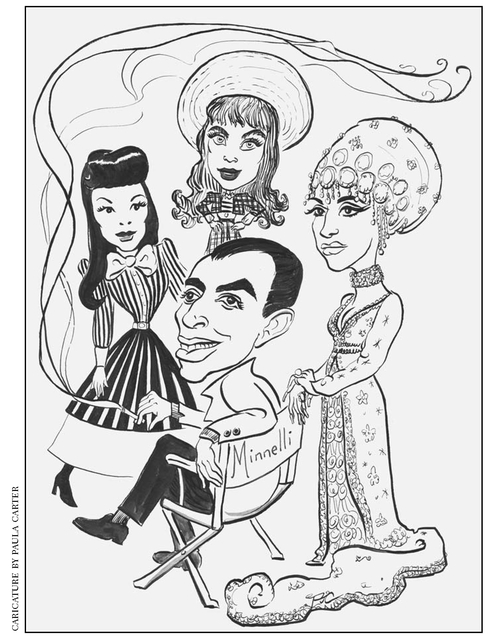Mark Griffin
Authors: A Hundred or More Hidden Things: The Life,Films of Vincente Minnelli
Tags: #General, #Film & Video, #Performing Arts, #Motion Picture Producers and Directors, #Minnelli; Vincente, #Entertainment & Performing Arts, #United States, #Motion Picture Producers and Directors - United States, #Biography & Autobiography, #Individual Director, #Biography


Table of Contents

For Lester

INTRODUCTION
I WAS SIXTEEN YEARS OLD when I saw the movie that changed my life. During a summer vacation in which I was expected to evolve from sophomore to junior, I actually went a step further and found myself. My life-altering cinematic experience came courtesy of
On a Clear Day You Can See Forever
, the second-to-last directorial effort of the great Vincente Minnelli. This decidedly offbeat musical not only featured a time-traveling protagonist with paranormal powers but came complete with a poignant theme about the liberating effects of self-acceptance—a message all too eagerly received by St. Dominic Regional High School’s resident misfit.
On a Clear Day You Can See Forever
, the second-to-last directorial effort of the great Vincente Minnelli. This decidedly offbeat musical not only featured a time-traveling protagonist with paranormal powers but came complete with a poignant theme about the liberating effects of self-acceptance—a message all too eagerly received by St. Dominic Regional High School’s resident misfit.
I watched
On a Clear Day
over and over in the summer of 1984. I found it healing and empowering. My friends thought I had lost it. They began to look at me funny. In an era dominated by
Return of the Jedi
and
Ferris Bueller’s Day Off
, was I actually claiming to have achieved some sort of cosmic consciousness through repeated viewings of . . .
a Barbra Streisand movie
? It was suggested that I should try getting out more often or maybe join a rugby team . . . before it was too late. But after discovering that
Village Voice
critic Andrew Sarris had once referred to the object of my obsession as “an underrated masterpiece,” there was no stopping me. This high-level endorsement was the only excuse I needed to study said masterpiece with an even more attentive eye.
On a Clear Day
over and over in the summer of 1984. I found it healing and empowering. My friends thought I had lost it. They began to look at me funny. In an era dominated by
Return of the Jedi
and
Ferris Bueller’s Day Off
, was I actually claiming to have achieved some sort of cosmic consciousness through repeated viewings of . . .
a Barbra Streisand movie
? It was suggested that I should try getting out more often or maybe join a rugby team . . . before it was too late. But after discovering that
Village Voice
critic Andrew Sarris had once referred to the object of my obsession as “an underrated masterpiece,” there was no stopping me. This high-level endorsement was the only excuse I needed to study said masterpiece with an even more attentive eye.
I was mesmerized by what Sarris had referred to as “Minnelli’s morbidly beautiful mise en scène,” and there was an unusual quality about the film that I was eager to reconnect with. Although
On a Clear Day
was a large and lavish major studio production, there was also something endearingly personal about it. Minnelli seemed to exhibit a genuine empathy for his heroine, who throughout the film grapples with the effects of a split self.
On a Clear Day
was a large and lavish major studio production, there was also something endearingly personal about it. Minnelli seemed to exhibit a genuine empathy for his heroine, who throughout the film grapples with the effects of a split self.
As I would soon discover, Daisy Gamble—the psychically gifted, identity-challenged chain-smoker at the center of
On a Clear Day
—was the kind of conflicted character that Vincente Minnelli had practically patented. Here was another engaging oddball to add to the director’s already impressive collection of visionaries, dreamers, artists, and outcasts. An awkward, un - assuming “go-alonger,” Daisy is so ashamed of her extrasensory abilities that she attempts to suppress this part of herself, terrified that someone will discover that she is (in her own words) “un-normal.” Besides her supernatural skills, Daisy harbors another secret—there is a more alluring, alternate identity buried within her. Several lifetimes ago, this neurotic wallflower from Mahwah, New Jersey, was Lady Melinda Tentrees, a clairvoyant noblewoman and 1814’s “It” Girl. Melinda’s captivating personality, regal bearing, and eye-popping ensembles effortlessly upstage Daisy’s modern-day existence.
On a Clear Day
—was the kind of conflicted character that Vincente Minnelli had practically patented. Here was another engaging oddball to add to the director’s already impressive collection of visionaries, dreamers, artists, and outcasts. An awkward, un - assuming “go-alonger,” Daisy is so ashamed of her extrasensory abilities that she attempts to suppress this part of herself, terrified that someone will discover that she is (in her own words) “un-normal.” Besides her supernatural skills, Daisy harbors another secret—there is a more alluring, alternate identity buried within her. Several lifetimes ago, this neurotic wallflower from Mahwah, New Jersey, was Lady Melinda Tentrees, a clairvoyant noblewoman and 1814’s “It” Girl. Melinda’s captivating personality, regal bearing, and eye-popping ensembles effortlessly upstage Daisy’s modern-day existence.
After coming to terms with her previous incarnations, Daisy experiences an exhilarating moment of self-discovery: The most important person you will ever be is the one that you are right now. As she begins to blossom as vibrantly as the azaleas, peonies, and posies that have surrounded her in virtually every frame, Daisy embraces her authentic self: “
On a clear day . . . rise and look around you and you’ll see who you are. . . . On a clear day, how it will astound you that the glow of your being outshines every star.
” I took the message to heart. And apparently so had Minnelli.
On a Clear Day
had inspired me to look at myself in a very different way. The gift of self-empowerment had been bequeathed to an insecure adolescent in need of reassurance. I was beyond grateful and very curious to know more about the man behind the movie.
On a clear day . . . rise and look around you and you’ll see who you are. . . . On a clear day, how it will astound you that the glow of your being outshines every star.
” I took the message to heart. And apparently so had Minnelli.
On a Clear Day
had inspired me to look at myself in a very different way. The gift of self-empowerment had been bequeathed to an insecure adolescent in need of reassurance. I was beyond grateful and very curious to know more about the man behind the movie.
I had been a card-carrying Judy Garland fanatic since childhood, and because I had seen all the films in which “the world’s greatest entertainer” had been directed by her second husband, I thought I was rather well acquainted with Vincente Minnelli. Largely because of
Meet Me in St. Louis
, I equated his name with an unmistakable style and the kind of exquisitely crafted extravaganzas that had long ago vacated the neighborhood movie house and taken up residence on the late show. Though, as I soon learned, there was more to Minnelli than what initially dazzled the eye.
Meet Me in St. Louis
, I equated his name with an unmistakable style and the kind of exquisitely crafted extravaganzas that had long ago vacated the neighborhood movie house and taken up residence on the late show. Though, as I soon learned, there was more to Minnelli than what initially dazzled the eye.
During the remainder of my summer vacation, I ravenously consumed some of the other important titles in the director’s oeuvre:
The Pirate
,
An American in Paris
,
The Band Wagon
,
Tea and Sympathy, Gigi
, and Minnelli’s tragically mutilated final film,
A Matter of Time
. While these movies were often boldly innovative, even ahead of their time, somehow they also felt strangely familiar. Despite the fact that almost all of these pictures had been produced long before I was born, it was as though Vincente Minnelli had somehow been eavesdropping on my dreams. No, better than that . . . he
was telling the story of my life on film, and by this point, my friends were
begging
me to get out more often. Though I really didn’t care. Minnelli’s movies were taking me to important places within myself and that was all that mattered.
The Pirate
,
An American in Paris
,
The Band Wagon
,
Tea and Sympathy, Gigi
, and Minnelli’s tragically mutilated final film,
A Matter of Time
. While these movies were often boldly innovative, even ahead of their time, somehow they also felt strangely familiar. Despite the fact that almost all of these pictures had been produced long before I was born, it was as though Vincente Minnelli had somehow been eavesdropping on my dreams. No, better than that . . . he
was telling the story of my life on film, and by this point, my friends were
begging
me to get out more often. Though I really didn’t care. Minnelli’s movies were taking me to important places within myself and that was all that mattered.
Eventually, I was able to see beyond my sixteen-year-old’s self-absorption and recognize that Minnelli wasn’t telling the story of my life on screen but his own. Or at least it seemed so. “My romanticism has never precluded me from my work which, in the final analysis, is the story of my life,” Minnelli observed in his 1974 memoir.
1
A lifelong workaholic, the director was probably referring to the countless hours he put in on Hollywood soundstages over the years. Though I hoped that what he also meant by this was that his work actually contained the story of his life. For I purely loved the notion of Minnelli as a mild-mannered subversive who labored under the constraints of the studio system yet somehow managed to sneak autobiographical elements into his films . . . buried-treasure style.
1
A lifelong workaholic, the director was probably referring to the countless hours he put in on Hollywood soundstages over the years. Though I hoped that what he also meant by this was that his work actually contained the story of his life. For I purely loved the notion of Minnelli as a mild-mannered subversive who labored under the constraints of the studio system yet somehow managed to sneak autobiographical elements into his films . . . buried-treasure style.
If Minnelli’s movies are indeed autobiographies in code (and many can certainly be “read” that way), his achievement is all the more extraordinary when one considers the fact that all but three of his pictures were made during his twenty-six-year association with Metro-Goldwyn-Mayer, Hollywood’s preeminent “Dream Factory”—but a factory nonetheless. I was intrigued. Just how had Vincente managed to produce such self-reflexive and personal work while toiling away at the most conservative and lockstep of the major studios? And what exactly was the work telling us about his life?
After scrutinizing the films, I started reading everything I could about Minnelli. I was interested in what made Vincente tick, not only as an artist but as an individual, though most of the information I could find about him focused almost exclusively on his directorial achievements. Before too long, references to auteur theories, surrealism, and
Cahiers du cinéma
began creeping into my conversation. I learned that although Minnelli had won an Oscar in 1959 (for his direction of
Gigi
) and several of his titles invariably turned up on lists of the Best Films Ever Made, he was more acclaimed in Europe than he was in his own country.
Cahiers du cinéma
began creeping into my conversation. I learned that although Minnelli had won an Oscar in 1959 (for his direction of
Gigi
) and several of his titles invariably turned up on lists of the Best Films Ever Made, he was more acclaimed in Europe than he was in his own country.
I now felt very protective, almost proprietary about my favorite director, and it irked me that he was sometimes treated like a second-class citizen. Although most critics and film scholars would readily acknowledge that Vincente Minnelli was “the master of the decorative image,” they seemed reluctant (until recently) to discuss his work in the same way one would approach Orson Welles, John Ford, or Jean-Luc Godard. Why? Did Judy Garland, Technicolor, and a score by Lerner and Loewe automatically disqualify Minnelli from being taken seriously as a director?
“The curse of Vincente Minnelli is really the curse of eighty-five percent of Hollywood’s great artists,” says film scholar Jeanine Basinger:
Jerry Lewis is a great filmmaker but, you know, he just acts funny. Raoul Walsh is a great director but he just makes action and gangster films. It’s really the curse of people not taking Hollywood seriously. A lot of artists get dismissed on the basis of something like, “If it isn’t Ingmar Bergman, it can’t be good.” In some ways, people fear fantasy. They fear escapism. They’re afraid it’s trivial. And people don’t want to take film on it’s most artistic terms. They don’t want it to fly and soar and be visual and stunning. Because none of that is “serious.” All of this is reflected in the way people approach Minnelli, apologizing for him or downgrading him. . . . Say that someone is watching the dream sequence in
Yolanda and the Thief
and they’re easily dismissing it. Then suppose I told them that it had been directed by Fellini, would they still be so quick to dismiss it? Of course they wouldn’t.
2
Yolanda and the Thief
and they’re easily dismissing it. Then suppose I told them that it had been directed by Fellini, would they still be so quick to dismiss it? Of course they wouldn’t.
2
Other books
Lost Books of the Bible by Joseph Lumpkin
The House on First Street: My New Orleans Story by Julia Reed
Poisoned Blue (Jamie Stanley Crime Scene Investigation Series Book 1) by Katie L Thompson
The 13th Witch Complete Trilogy by Thompson-Geer, Stacey
Chris Mitchell by Cast Member Confidential: A Disneyfied Memoir
Of Witches and Warlocks: The Demon Kiss by Lacey Weatherford
Between Before and After by Dick, Amanda
The Flying Pineapple by Jamie Baulch